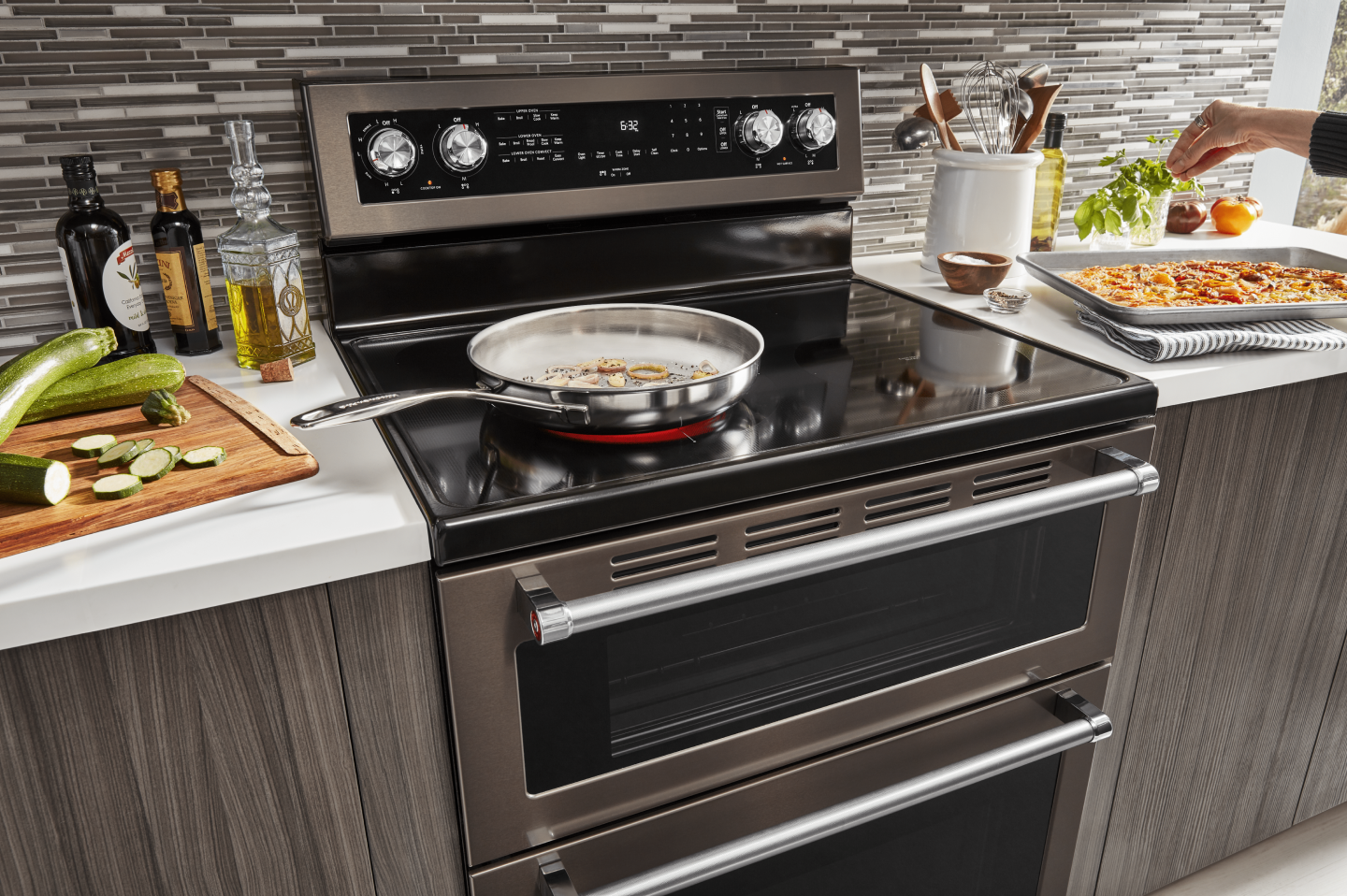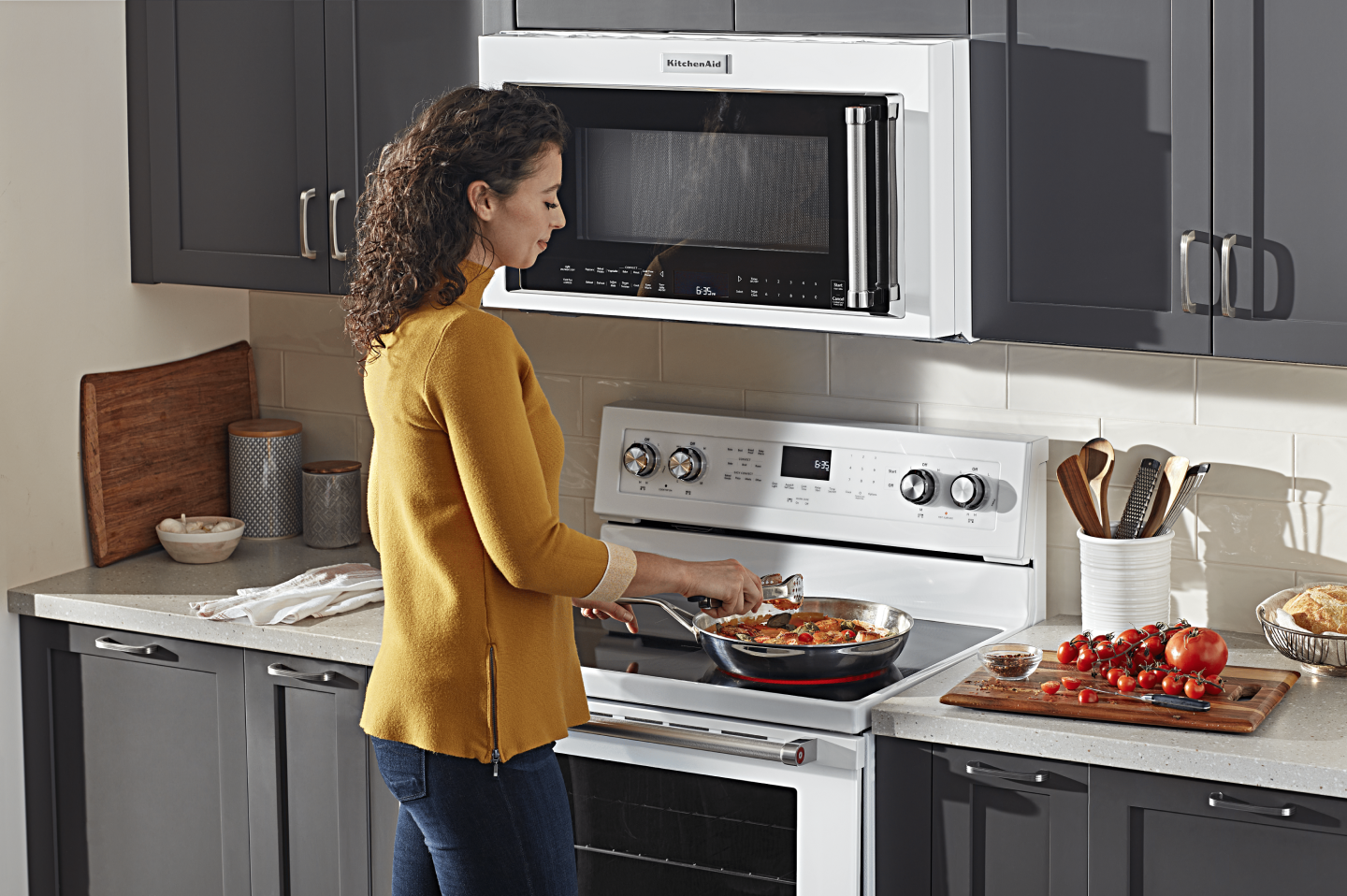
How to convert a gas stove to an electric model
Electric ranges deliver responsive oven heat and a stovetop that’s versatile and easy to clean, but converting to an electric range may not feel as seamless as creating with one. Follow the 5-step checklist below to learn about the gas stove to electric conversion process.
Can you change a gas stove to electric?
You can transition from a gas to an electric stove if your home meets electrical supply requirements and you employ the help of certified professionals. An expert can turn off the gas and cap the gas line as they remove the stove to help prep your space for an electric model. You may also need to hire a contractor to run a new electrical line and install an outlet.


Converting a gas stove to electric: A step-by-step guide
You can convert gas stoves to electric by following the 5-step guide below. Read on to learn how to check for electrical requirements, plan a wiring route, work with contractors, choose a new range and get your electric range installed.
Step 1: Check electrical requirements
Your gas stove can operate connected to a standard 110-volt outlet, but electric stoves use more power and require a 220-volt outlet with circuitry that produces 40–50 amps of power at minimum. Check your electric panel to find out if your breaker box is ready to make the transition. You can usually find this information printed near or on the main circuit breaker.
Step 2: Choose your new range
Electric ranges come in a wide variety of feature sets, capacities, configurations and styles. Make sure you measure the space of your range cutout accurately before you start shopping for ranges. Then, decide if a freestanding, slide-in or double oven model is best suited to the way you make.
Certain features may be a better fit for the types of dishes you create and techniques you’d like to explore. For instance, select KitchenAid® electric ranges feature the EasyConvect™ Conversion System that automatically adjusts conventional cooking temperatures to the appropriate convection setting. Some models even feature a steam rack that provides additional moisture in the oven so you can create a variety of textured dishes.
Step 3: Plan wiring route
If your space does not already have the required electrical outlets, you may need to install an electrical line that runs from your electric panel to your new electric range. You’ll need to work with a licensed contractor to complete this step. Take a look at the area surrounding your electric panel. Open ceilings should make it easier and less expensive to run wiring while enclosed or crawl spaces in the route may be more costly to navigate.
Be ready to talk with a technician about potential electrical needs like upgrading your breaker box, running wiring and installing a 220-volt outlet in one visit to help you save time and money throughout the process.
Step 4: Set up contractor appointments
Even if your space is already wired for an electric range, you’ll need to hire a professional to shut off and cap the gas line as they remove your stove. This can be done ahead of time to skip steps on installation day, or it can be done at the time of installation. If you have a contractor coming to install a new electrical setup, it might be a good time to have them handle shutting off your gas line as well.
Step 5: Plan for installation
Once you’ve laid the groundwork, decide whether you’d like to install the range yourself or arrange for a professional technician to install it for you. Expect installation to take anywhere from 1–2 hours. If you still need the gas line shut off, opt for professional installation. You can schedule service with an authorized KitchenAid service technician for help with installing KitchenAid brand ranges.


What is the cost to convert a gas stove to electric?
Costs of converting from gas to electric will vary depending on the electric model you choose and the contracting work you need done. You can estimate end costs by considering the price of purchasing, delivering and installing a new electric stove, and disposing of your old stove.
You should also factor in the price of hiring professionals to run a new electrical line and shut off and cap old gas lines. If the space near your electric panel is enclosed and without open ceilings, you can expect increased renovation costs for installing a new electrical line.
Tips for switching from gas to electric stove
You should consider more than transitioning from gas to electric hookups when you convert your stove. Before you start the conversion process, be sure to:
Gather measurements: You’ll need to know measurements for both your new range and the range cutout space in your kitchen. You’ll get the most accurate measurements by removing your existing stove prior to measuring the depth, width and height of your cutout.
Consider your range hood: Gas stoves usually require a higher CFM (Cubic Feet per Minute) for venting the space above the stovetop. You can keep your existing range hood when transitioning to an electric stove, but if you choose to buy a new one, you should be able to purchase a less powerful hood.
Choose cookware: Most cookware is effective with both gas and electric stove models, but you may need to invest in new cookware with magnetic bottoms if you replace your gas model with an induction stove.
Explore KitchenAid®stoves
KitchenAid® slide-in and freestanding electric ranges let you do more with flexible cooking elements and large oven capacity. Select models feature Even-Heat™ True Convection to help crisp, bake, brown and caramelize dishes in the oven. Plus, an integrated downdraft ventilation system on select models helps remove smoke and odors while eliminating the need for a separate range hood.
Learn more about stoves from KitchenAid brand
-
 Range vs. Stove vs. Oven: Is There Really a Difference? Learn the difference between a range, a stove and an oven, then discover what’s the best fit for your kitchen.
Range vs. Stove vs. Oven: Is There Really a Difference? Learn the difference between a range, a stove and an oven, then discover what’s the best fit for your kitchen. -
 Slide-In vs. Freestanding Range Guide Slide-in ranges offer a built-in look while freestanding ranges provide flexibility. Compare features, sizes and benefits to choose the right range for you.
Slide-In vs. Freestanding Range Guide Slide-in ranges offer a built-in look while freestanding ranges provide flexibility. Compare features, sizes and benefits to choose the right range for you. -
 Dual Fuel vs. Gas vs. Electric vs. Induction Ranges What is a dual fuel range, and what are its benefits? Explore pros and cons of dual fuel ranges. Compare dual fuel to gas and electric ranges in this guide.
Dual Fuel vs. Gas vs. Electric vs. Induction Ranges What is a dual fuel range, and what are its benefits? Explore pros and cons of dual fuel ranges. Compare dual fuel to gas and electric ranges in this guide.
